#forensic science objective
Explore tagged Tumblr posts
Text
Anyway, now that police are saying Luigi Mangione's fingerprints match those found at the crime scene, reminder that:
fingerprint evidence is flawed and the idea that no two people have identical prints is unproven
they matched his prints to those found on a water bottle and protein bar found near the crime scene and apparently the shooter is the only person who has ever littered in New York before.
#luigi mangione#united healthcare#uhc shooter#uhc ceo#uhc assassin#brian thompson#fingerprints#forensic science is not the bastion of objectivity you think it is#TV lied to you
92 notes
·
View notes
Text
Multiple Choice Questions on Forensic Medicine
1. The visual disturbances seen in methyl alcohol poisoning include all of the following, except? A) Concentric diminution of visual fields for color and form B) Pinpoint pupils C) Photophobia and blurred vision D) Sudden failure of vision
Continue reading Multiple Choice Questions on Forensic Medicine
#crime scene investigation#Forensic Medicine Mcq With Answer#Forensic science#mcq on forensic medicine#Multiple Choice Questions On Fingerprints#Multiple Choice Questions On Forensic Medicine#Multiple Choice Questions On Forensic Toxicology#Objective On Forensic Medicine
5 notes
·
View notes
Text
Writing References: World-Building
20 Questions ⚜ 100 Words for World-building
Basics: World-building ⚜ Places ⚜ Imagery ⚜ Setting
Exploring your Setting ⚜ Habitats ⚜ Kinds of Fantasy Worlds
Fantasy World-building ⚜ World-building Vocabulary
Worksheets: Magic & Rituals ⚜ Geography; World History; City; Fictional Plant ⚜ A General Template
Editing
Setting & Pacing Issues ⚜ Editing Your Own Novel
Writing Notes
Animal Culture ⚜ Autopsy ⚜ Alchemy ⚜ Ancient Wonders
Art: Elements ⚜ Principles ⚜ Photographs ⚜ Watercolour
Creating: Fictional Items ⚜ Fictional Poisons ⚜ Magic Systems
Cruise Ships ⚜ Dystopian World ⚜ Parts of a Castle
Culture ⚜ Culture Shock ⚜ Ethnocentrism & Cultural Relativism
Food: How to Describe ⚜ Lists ⚜ Cooking Basics ⚜ Herbs & Spices ⚜ Sauces ⚜ Wine-tasting ⚜ Aphrodisiacs ⚜ List of Aphrodisiacs ⚜ Food History ⚜ Cocktails ⚜ Literary Cocktails ⚜ Liqueurs ⚜ Uncommon Fruits & Vegetables
Greek Vases ⚜ Sapphire ⚜ Relics ⚜ Types of Castles
Hate ⚜ Love ⚜ Kinds of Love ⚜ The Physiology of Love
Mystical Objects ⚜ Talisman ⚜ Uncommon Magic Systems
Moon: Part 1 2 ⚜ Seasons: Autumn ⚜ Spring ⚜ Summer
Shapes of Symbols ⚜ Symbolism ⚜ Slang: 1930s
Symbolism: Of Colors Part 1 2 ⚜ Of Food ⚜ Of Storms
Topics List ⚜ Write Room Syndrome
Vocabulary
Agrostology ⚜ Allergy ⚜ Architecture ⚜ Baking ⚜ Biochemistry
Ecology ⚜ Esoteric ⚜ Gemology ⚜ Geology ⚜ Weather ⚜ Art
Editorial ⚜ Fashion ⚜ Latin Forensic ⚜ Law ⚜ Medieval
Psychology ⚜ Phylogenetics ⚜ Science ⚜ Zoology
More References: Plot ⚜ Character Development ⚜ Writing Resources PDFs
#writing reference#worldbuilding#setting#writing tips#writing advice#writeblr#dark academia#spilled ink#literature#writing prompt#creative writing#fiction#writers on tumblr#story#novel#light academia#writing resources#compilation requested by anon#will update every few weeks/months
5K notes
·
View notes
Text
Alegría v Caruso: Day 2, Pt. 1

Everybody was seated, waiting for the trial to resume after what seemed like a never-ending weekend. Seriously, it felt like 4 months (and 7 days, if we want to be exact).
While Erick and Ángel felt a little uneasy after how Day 1 ended, Noemí was rather optimistic. She would feel comforted knowing Dulce was on the right side, even if the jury made a decision against her.
Lewis, however, felt pretty guilty for not sharing his suspicions regarding Caruso. In his defense, most people probably wouldn't like being told, "Your partner is a shady, lying jerk. And he squeezed my hand too hard."
When Lewis confessed this to Dulce, she forgave him. It didn't matter anymore. Yeah, maybe she wouldn't have believed Lewis, and that thought was unsettling.

On the other side of the room, Isabela was silently scolding Caruso for... reasons.
Hold on, were they trying to match outfits like Dulce and Antonio? The audacity when their claim was Caruso's "originality"...
It didn't take long for Caruso to be spared from the continuous bickering. The judge walked into the courtroom and took a seat, making Isabela settle down.
"This court is now in session," he announced. It was showtime.

Antonio stood up from his seat and walked over to the judge's bench.
“Your Honor, today we present a crucial piece of evidence: Ms. Alegría’s personal notebook, containing years’ worth of handwritten notes and original recipes.”
Chatter was heard around the room. What an interesting development.

Isabela shot up from her seat. “Objection! The notebook could have been fabricated over the weekend.”
A valid concern, but the judge was much too intrigued. “Overruled. We will hear the evidence first.”
Isabela remained firm, determined to cast doubt. “But, Your Honor. The defense was not made aware of this evidence before today.”
“Ms. Alegría could not find it, and we were unsure it would be found on time," Antonio explained.

That is technically the truth. Dulce was impressed with Antonio's ability to say just enough.
Antonio added, "Given that it contains important material to this case, we ask for it to be admitted."
“I will allow it.” His nod signaled for Antonio to continue.

“This notebook contains the ingredient lists and handwritten revisions. Momentarily, the ink analysis expert will verify when these entries were made.”
The screens behind him showed photographs of the pages from the notebook. The jurors nodded listened attentively.


Dr. Nadia Galecki, a forensic document analyst, was called to the stand.
Antonio began. "Dr. Galecki, can you explain how you determined the authenticity of this piece of evidence?"
"Using chemical testing, we conducted an ink dating analysis to determine when the ink was applied to the pages. The compounds in ink change over time, and by measuring these changes, we can estimate how long ago something was written."

"And what conclusions did you draw?"
"Based on our tests, the majority of the entries predate Ms. Alegría's relationship with Mr. Caruso by several years—some, nearly a decade."
The people in the courtroom whispered, and Caruso could not believe what was happening. How is he so good at this? He can't be real.
"Thank you, Dr. Galecki. No further questions." Checkmate.

It was Isabela's turn. "Dr. Galecki, ink dating analysis is not an exact science. How precise are these results, really? Could there be a margin of error of weeks? Months? ...Years?"
The analyst seemed to take offense to that. "It is a highly reliable method. Science is never absolute, but our tests can generally determine whether the ink was applied within a certain time frame. We use multiple techniques to ensure accuracy."
"But you also found that some entries were written after Ms. Alegría met Mr. Caruso, right?"
Dr. Galecki did not falter. "Yes, but it does not change the fact that the majority of the notebook is older than their relationship."
Isabela frowned.

Meanwhile, Dulce was pleased with how things were going. She hoped her joy wasn't too obvious. Winning was always fun.
Start from the beginning (Gen 2)
Previous | Next
#Dulce Alegria#Noemi Alegria#Erick Wade#Angel Alegria#oc mlt: Antonio Romero#oc mlt: Caruso#oc mlt: Isabela Campos#tjolc gen 2#tjolc#alegria legacy#matchalovertrait#joy of life challenge#joy of life legacy#the sims 4#ts4#sims 4#sims 4 legacy#tjol challenge
102 notes
·
View notes
Text
Anubis
Offerings
Water, wine, whiskey, rum, scotch, beer, black coffee, milk, juice, teas, energy drinks.
Meat, fish, fruits and vegetables, bread, grains, nuts, honey, cakes and other sweets, too (like dark chocolate or cinnamon flavored candies). Spices (like turmeric, cinnamon, pepper, paprika, saffron, etc.) and spicy food.
Plants or scents (perfumes, incense, candles, essential oils) like like lavender, frankincense, myrrh, cedar wood, sandalwood, cassia, eucalyptus, camphor oil, cedar oil, peppermint, rose, thyme, and almond oil. (Please make sure these are okay to burn before doing so).
Knives, bow and arrows, or other weapons can be dedicated to Inpw.
Precious metals and stones like gold, silver, lapis lazuli, obsidian, onyx, black tourmaline, smokey quartz.
Funerary objects and materials like natron, linen bandages, imagery/figurines of the canopic jars, heart scarabs, coffin imagery/figurines, acacia gum or gum arabic.
Items like the feather of maat, scales of justice, the ankh, the sekhem scepter, the was scepter, the double crown, the crook and flail, You may also offer him imagery of him, a seated/laying down dog, or any of the previous objects listed (drawings, printed pictures, figurines).
Devotional Acts
Visit a cemetery and help clean up graves. Pay respects to the dead and help make their graves look nice, decorate it with flowers, or ask to pour out a libation to the deceased when you go and visit. Clean up any debris or trash you found around the site. Along these lines, getting in the habit of saying a prayer for the deceased to have an easy transition is also a great devotional act. You don’t have to address anybody in particular, just the act is enough.
If you have any desire to go into death work that can be a great devotional act- this can be done by being a death doula, mortuary science, death investigation, autopsy technician, forensic science technician, funeral assistant, etc. Helping the dead and treating them with respect is always appreciated.
Fostering dogs or helping out at dog shelters is a great devotional act for Anpu!
Volunteer at an orphanage. Anubis is associated with orphans, so helping those who have lost their parents can be incredibly beneficial to the child and something you can do in honor of him.
Doing things that will help make your heart lighter at the end of your life. This is going to look different person to person but it can include coming out if you’re closeted, being true to yourself, setting boundaries, dealing with your trauma and going to therapy to unpack whatever it is that you’ve been through, getting on medication for any mental illness you have, going down a career path you’re passionate about, picking up new hobbies, making new friends that will help you, finding a community that will accept you, etc. Again, this will look different for everybody. Ask yourself what will make your heart feel lighter at the end of your life?
Signs
Anubis is well known for sending dogs along people’s paths. I’ve seen that he’s most likely to send black dogs to a person- they may appear randomly along your path or they could appear as a stray dog looking for a home. He may also send you jackals, wolves, coyotes, foxes, or leopards- depending on what’s native to your area but they may also appear randomly through images. Along these lines, you could also come across scared signs and symbols of him, or you may see him.
You may get feelings of easiness, calmness, as well.
Signs from him could be your own life transforming around you. You could see yourself transforming much faster, where you’re learning lessons that you need to or you’re getting on a career path that will help you. Transformation can also take the form of being better at setting boundaries or becoming a better communicator.
As the god who renews the life of the dead, you could find yourself with renewed hope, feeling refreshed, or just an overall better outlook of life.
#anubis#inpw#offerings; devotional acts; signs#offerings#devotional acts#signs#offerings to anubis#devotional acts for anubis#signs from anubis#anpu#kemetic#kemetic paganism#kemetism#ancient kemet#pagan#paganism#ancient egypt#deity worship#deity work
76 notes
·
View notes
Text
An Undergraduate Forensic Viewing of Like Minds (2006) Train Scene

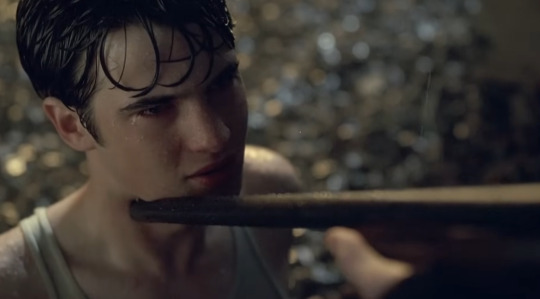
Pray for me. Pray for yourself. We are one now.
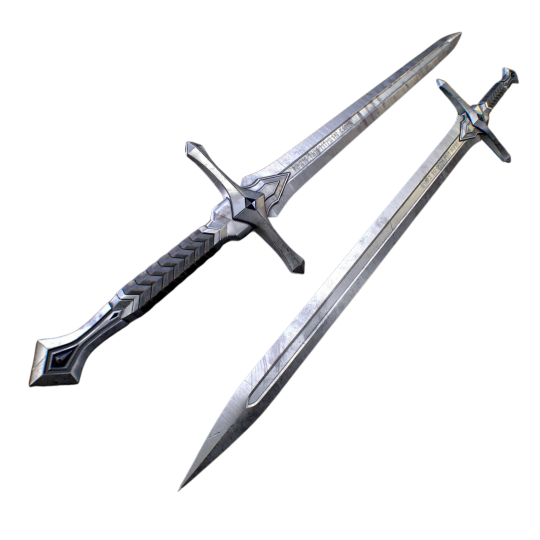
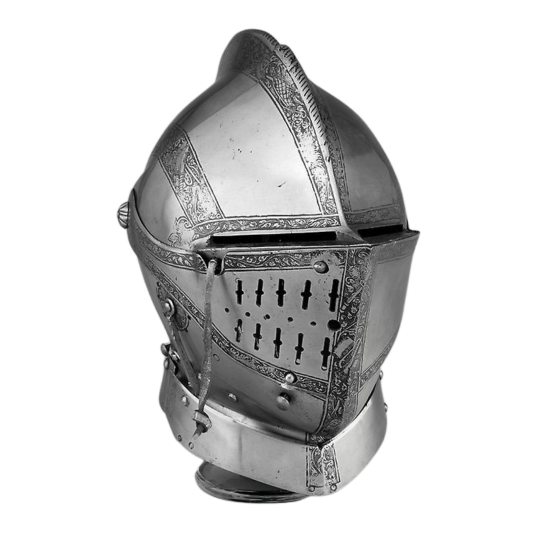
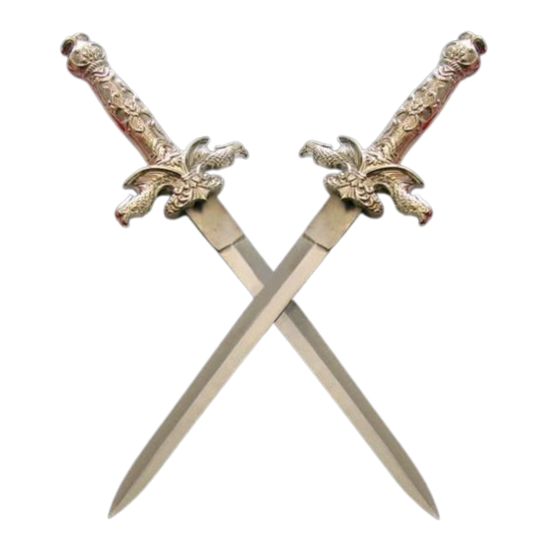
Contents:
1. Introduction 2. What We Know 3. The Investigation 4. Bibliography for Nerds

1. Introduction
Some justifications first.
I'm an undergraduate stem student obssessed with many topics, including forensic studies. I just finished a complete course about forensic chemistry/tecnology/law in uni and yes, I'm a big failure of a person and was thinking about applying some of the things I've learned into Like Minds' train scene. To clarify, I'm not an experienced profissional of the field. It is to say, I've never worked in such area and had just one or two significant interaction with said profissionals and students. My considerations won't be 100% accurate, clearly, and I may mistake or ignore fundamental data and studies. I intend solely to present some interesting facts and rapidly discuss their applicability here.
Take everything I say with large grains of salt, this is mostly for my enjoyment.
Let's kill Nigel!
2. What We Know
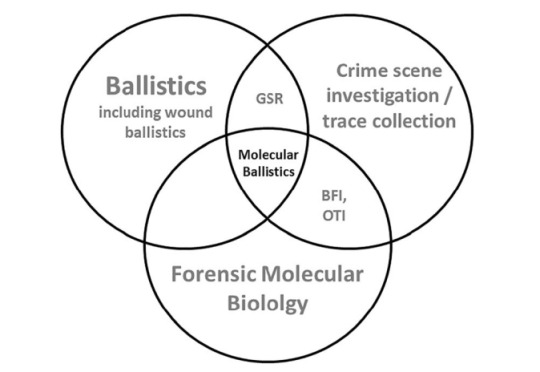
Figure 1. Visual diagram of forensic ballistics' main areas of study. Some will be mentioned here. [1]
2.1. Ballistics - Anatomy of a Discharge
Ballistics is a science field divided in three main ramifications: (1) Interior Ballistics, (2) Exterior Ballistics and (3) Terminal Ballistics. (1) studies the mechanism of a gun discharge, (2) studies the trajectory and behavior of a projectile once it is ejected from a firegun and (3) studies the damage and overall interaction of the projectile with a material structure (biological or not). [1] Ballistics experts (chemists, some engineers, law experts, etc) ocuppy themselves with many things regarding firearms, a field of work that recuries much study and understading of multiple fields of knowledge such as spectroscopy, law and general legislation, physical properties of chemical coumponds, solid state science, material science, industry production series and others. Some areas of chemistry and biology are of great importance and are commonly used complementarily.
We then understand what bullets are. The component that effectivally hits the target in these scenarios is the actual "projectile".
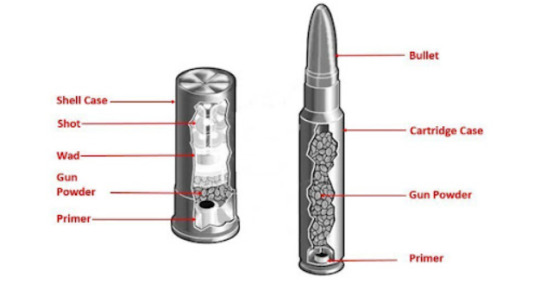
Figure 2. Simple structure of shotgun (left) and rifle (right) ammunition. [2]
In simple terms, they're composed by (1) a shell that holds everything together, (2) some coumpond responsable for the liberation of gas via chemical reaction and (3) some way to give the heat needed for said reaction to occur. There is a whole field of study and production of these killing objects that seeks out to balance some of their properties in different scenarios by the armamentist industry in oder to supply endless applications that constantly develops new shapes and components, so going through it all would be impossible. Regardless, all ammunition is classified by size, called "gauge" in shotguns, and "caliber" in rifles and handguns. [2]
Case: [in shotguns] It is a small cilindrical piece made out of a tube of common plastic or sturdy paper (the red/blue/colored part) that holds the multiple projectiles to be fired (shots), with a metallic base (the primer) composed of brass (copper and zinc) or steel (iron and carbon). [in rifles] The case is called cartridge case, and it is composed by brass as well. [2]
Powder (or propellant): They are usually Nitroclelullose (handguns), Nitroclelullose/Nitrogliceryn (rifles) and Nitroclelullose/Nitrogliceryn/Nitroguanidyn (long range rifles) [3]. Oversimplifying, organic molecules containing nitro groups (present in Nitroclelullose, Nitrogliceryn and Nitroguanidyn) are really unstable; these chemical groupaments are highly reactive in face of many scenarios. If enough energy is provided (by heating, or mechanical contact and pertubation) they will enter a decompostion process, breaking and reacting with their own bonds spontaneously, liberating gases such as H2O, N2 and CO2. These mentioned gases are much more stable compared to the original organic coumponds, so the atoms will "prefer" to form these species if the conditions are set (thus, a spontaneous reaction). This increases pressure inside the shell and forces the projectile to leave violently as a result of gas expansion. [4] Shotgun powder is composed by potassium nitrate, charcoal and sulfur; a mixture known as "dark powder", and it is separated from the shot (projectiles; multiple balls of steel, lead, rubber, or really anything) by a small component called "wad". The same principle explained in the decomposition of organic nitro-compounds apply for the potassium nitrate present here, but only in the presence of sulfur (easier to melt and ignite), providing the necessary heat for potassium citrate to generate the oxygen needed, resulting in charchoal's combustion. [2]
Primer: Primers are a fundamental part of any ammunition, and yet a simple one. When a firing pin from the firegun hits them, sparkles and heat will be produced, which gives the propellent all requiered energy for the chemical reaction. It is, when the action lever is pulled, the firing pin is tensioned by a spring inside the gun. When the trigger is pulled, this firing pin hits rapidly the ammunition's primer (metallic base). [5]
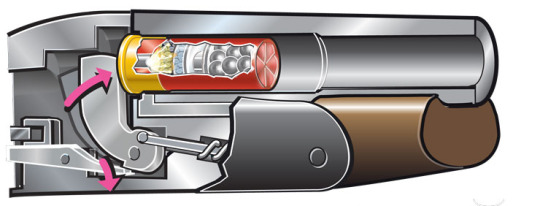
Figure 3. Shotgun firing pin scheme. [5]
The discussion of differents powders/propellents (like smokeless powder), projectiles shapes (in rifle cases) and firegun types (other than rifle and shotgun) is being ignored.
All that must be known is: the trigger pulling promotes a mechanical impact against the ammunition base, which promotes chemical reactions that liberate great amounts of gases, increasing the pressure inside the case, what will pushes the projectile(s) inside foward with great speed.
2.2. The Shotgun - Means to An End
We now restrain ourselfs to the firegun. Let us take a look on the following images:
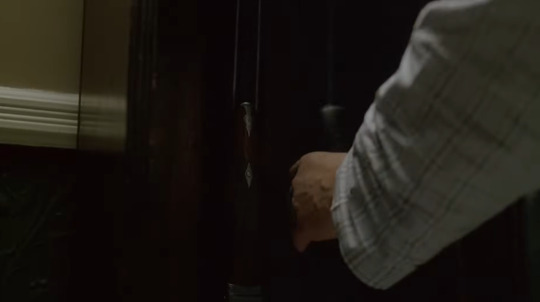
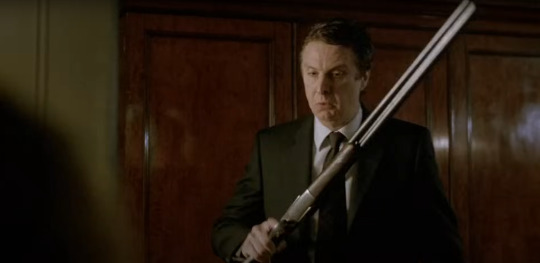
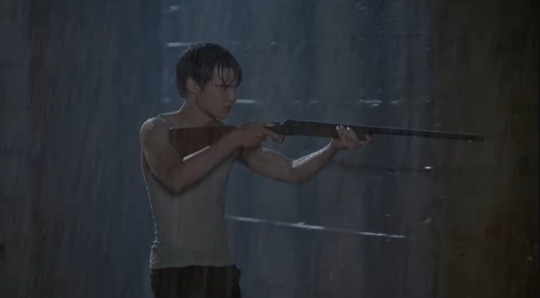
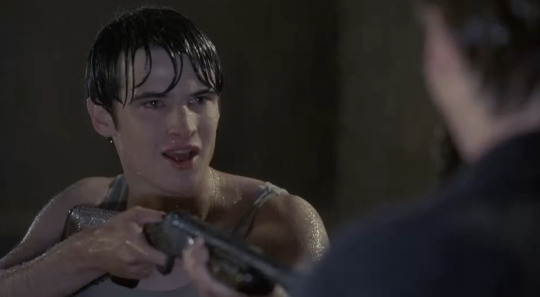
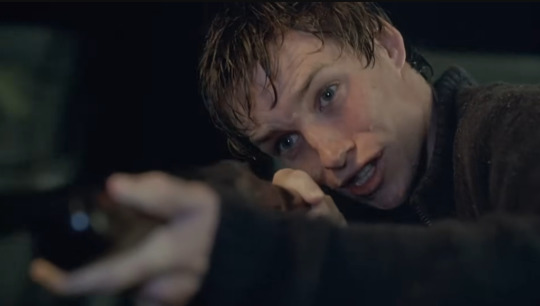
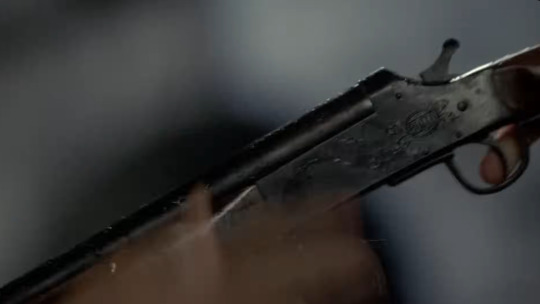
Figures 4-9 (left to right, top to bottom). Shotguns' takes from Like Minds (2006).
Main considerations:
The shotgun used by Mr. Colbie isn't the same one used by Nigel/Alex in the train scene. We can clearly point that by the number of barrels, i.e., two barrels contaning two projectiles (killing Nigel's mother and father without visible activation) in its first appearance, and only a single one in its second appearance. Maybe this has been discussed before.
It is not a narrative problem if we have the eyes for it. Nigel's father possesses two shotguns, so we assume Nigel went back and grabbed the single-barrel one before going after Alex.
The reloading thing would be important during the bedroom scene, between the moments where John shoots his wife and Alex picks up the gun from the floor. There would be no way of aciddentially shooting Mr. Colbie wihout Alex pulling the action on the second barrel (how would he know which one of the barrels were loaded and why Mr. Colbie would only activate one of the two barrels? It appears he wasn't using the shotgun to merely scare his family). Perhaps the double barrel shotgun used has some individual firing feature, perhaps.
Also, the single barrel shotgun is the same one used by John when Alex and Nigel first accessed the hidden baseament together. This isn't of great relevance though.
After a compulsive research in gun sale sites and over 900 models of shotguns (no joking), I'm inclined to believe that Nigel's single barrel shotgun is an Era 410 GA Single Shot Break Action. My conclusions is based on Figures 6 and 9, the shotgun's best takes throughout the entire movie. The important details are: a single barrel, with rounded trigger guard that ends exactly where the wooden stock begins, by a rounded break action lever with squarish shape that leans horizontally to the receiver and a rectangular like forestock. Other smaller details are: the receiver's top shape and really curved back, the declination present on the stock and the three screws' position and size.
The engraved symbols on Colbie's receiver are sculpted by a profssional artist called "engraver", by client's demand. Therefore, these sigils are decorative and probably carry some meaning to the shotgun's real owner, so they aren't a discrepancy to worry about. The frame I acquired (Figure 9) is of poor quality and there's nothing I can read in there besides one or two letters. I've tried to watch the movie in other internet sites but it didn't help that much.
It took me forever, but here it is [6], [7]. There are also youtube videos revewing this gun in the Extra section.
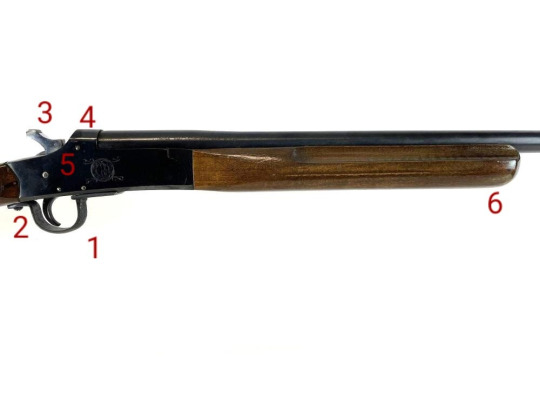
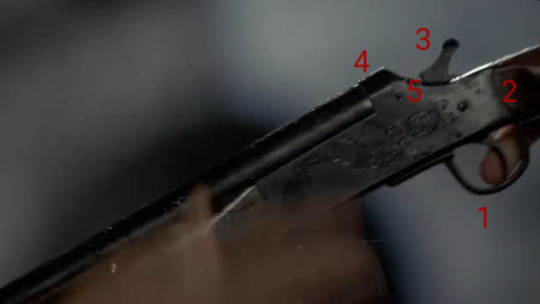
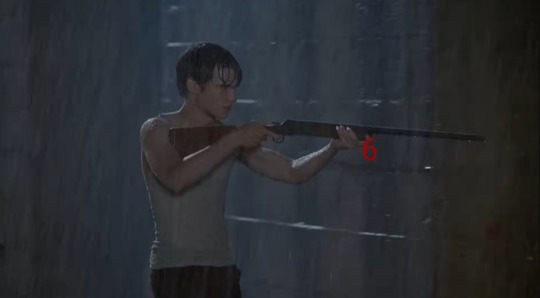

Figures 10-13. Era 410 GA Single Shot Break Action Shotgun. [6]
Note: @laurelwen successfully identified Nigel's firegun as a Boito .410. The text engraved on the shotgun's receiver in Figure 9, in fact, reads "Boito". Check it out on this post. Look up Extra Bibliography No. 7 in the shotgun's section as well.
Shotguns are a really old type of gun from the 16th century. Their mechanisms were adjusted during following centuries, but they remain still to date with an extremely simple way of function. Today, there are many types, including the single-shots and hand shotguns, much different than what was originally conceived. A break shotgun is capable of "breaking in half" for reloading, exposing its ejector/extractor and barrel interior just as many other fireguns. [8]
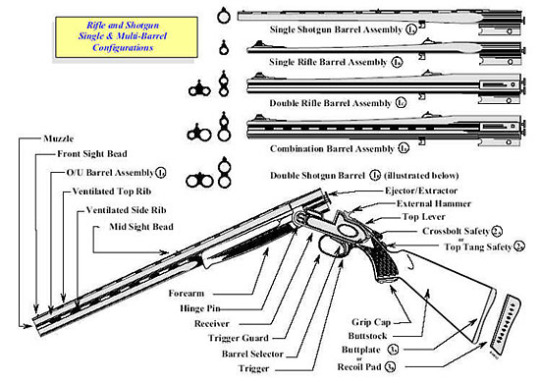
Figure 14. Break action shotgun anatomy. [9]
The Era 410 GA possesses a specially long length of barrel, which helps projectiles to achieve maximum velocity before leaving. Still, it appears from my research that this is a second hand model with low price, low demand and little historical relevance. This is the type of gun that would be bought mainly by collectors and enthusiasts; however, because of its little weight, good shooting and minimalist elegance, this firegun is not one of the worst models out there for small amateur animal hunting.
A 410 (10.41 mm, one smallest shot diameter in the market) with great pattern of dispersion after the discharge isn't bad, so at medium distances most projectiles would succesfully hit the center of a target. This is not very good when we're talking about a point-blank discharge directly at Nigel's face.
3. The Investigation
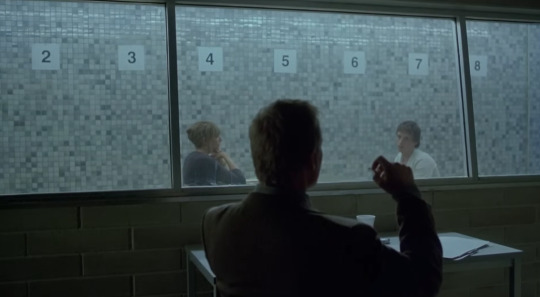
Figure 15. "If they had any evidence, I wouldn't be talking to you, would I?"
Authorities arrive at the dark, umid and isolated train tracks. Immediatly, a shocking scene: a desperate young man holding in his arms the corpse of a dead boy, disfigured. They transport the living witness away from the scene, but the lying unknown and deformed body is extracted for further autopsy. Detective McKenzie takes over with Forensic Psychiatrist Sally to interrogate the surviving suspect, Alex Forbes.
After the initial approach and first hours of interaction, the case takes an unexpected form. The question now is, did Alex Forbes shoot the now identified Nigel Colbie alone, or did Colbie participated in his own killing to incriminate Alex?
The police wastes its time thinking about common scenarios described in the book. They know the victim, the place where it happened, the exact gun used and the main suspect. Everything comes down to answering the presented question. Psycological attempts of extracting an answer from Alex by closed sessions with Sally, it is, to try and build a thrust and comfort relation with the suspect in order to obtain a confession would be protocol. But Alex clearly is beyond that, and if we must say, he's in control the whole time.
All that is left for the police is to attach towards factual evidences. Now, we describe two fundamental forensic elements of a gun-related crime.
Gunshot Residues (GSRs)
GSRs are one of the strongest evidences when it comes to forensic studies. Being composed of burnt and unburnt organic or inorganic particles from the explosive primer from the shell, propellant and possibly fragments of the bullet, cartridge case, and even the firearm, they frequently contain elements such as Sb (antimony), Ba (barium), Pb (lead) or Zn (zinc), Cu (cooper), and Ti (titanium). Their deposition concentrates away from the firearm into the shooter's (arms, face, hands and chest mainly) and victim's (region of contact mainly) bodies. GSRs can be found in nearby surfaces as well, such as the floor, ceiling, walls, objects, clothes, etc. The direct deposition of these residues must be carefully used as evidence because of its irregular distribution on the surrounding enviroment after the discharge. Thus, the main factors are always the chemical composition and concentration spots. Shotgun shots (the small spherical projectiles) are usually made up of lead or lead/antimony, but some ammunitions use steel, zinc-plated steel, tungsten and bismut in substitution (So, in our case, we can expect more significant ammounts of antimony/lead or zinc, iron and carbon). [10], [11]
A 410 ammunition is classified as "birdshots" ammunition, used for hunting said animals. The little diameter of projectiles allows the carrying of multiple projectiles inside one shell, facilitating the execution of small moving targets. The potential damage mustn't be underrated, though.
The aforementioned substances/elements can be detected, investigated, and quantified using microscopy, chemical analytical and chemometric methods, such as Scanning Electron Microscopy (SEM), Energy Dispersive X-Ray Spectroscopy (EDS), Atomic Absorption Spectroscopy (AAS) and Energy Dispersive X-Ray Fluorescence (EDXRF). All these techniques are extensively known and applied in uncountable areas of science for identification and characterization of solid materials. In a nutshell, these methods revolve around the interaction of matter with radiation (such as X-Rays) and the energy absorved/emitted by it after the interaction. The SEM is a most usefull analysis for it can provide real images of micro structures and particles present above any surface, like clothings, skin, fifregun metal and others, if properly prepared. [10]
It is important to understand that these identification methods are of extreme precision and sensibility, it is, minimal concentrations can and will be detected inneviatbly.
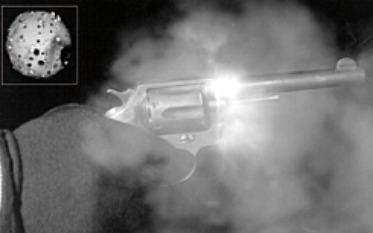
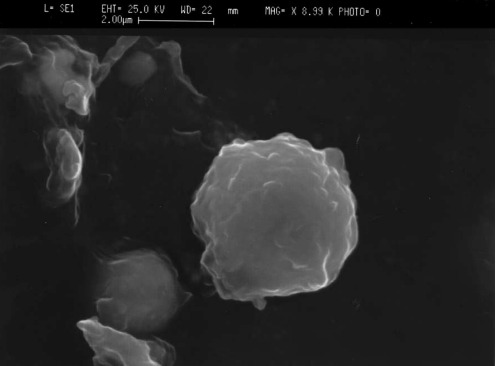
Figure 16 and 17. (Left) Image of gunshot powder residues dispersed in the air after discharge. Top left and (Right) images refer to SEM "photos" of extremely small particles of GSRs that can be chemically analyzed. [12], [13]
What about the lifespan of these residues? In long terms, the shooter's trigger hand (right hand) seems to contain most of the residues that persist for a fair amount of time after the discharge. [10] Unffortunately, the mentioned study occured in controlled enviroments, which is not the case. Another work [14] concludes that most GSRs are lost after two-four hours from the discharge. Considering the fast action from authorities described in the movie, we can basically ignore this factor and consider other variables.
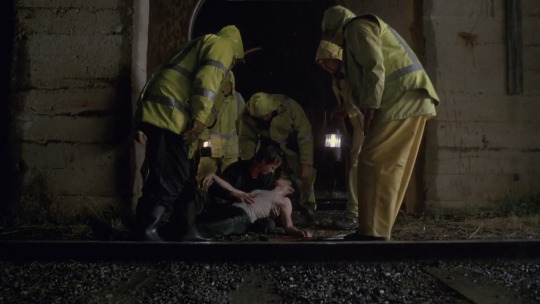
Figure 18. "All I can tell you, was that the heavens were falling. And the sound... it was incredible. It was like the Gods were rejoicing for what was done."
Backspatter Material (BM)

Figure 19. Distribution of Forward Spatter and Backspatter caused by a shot at a biological target. [1]
We hereby exclude the forward spatter, it is, the biological material projected fowards with the projectile (to the back of Nigel's head), for its little relevance, since we're not questioning the type of gun or ammunition used; we assume that Alex is describing a resonable scenario that matches with the actual damage done to Nigel. There are no consistent reasons to question this since everythings seems to support Alex's description of this.
BM comes from the combined forces of several interacting wound and ballistics effects. The collapse of the wound cavity and balance of resulting overpressure, the stream of liquid and tissue particles accelerated along the lateral surface of the projectile, the shot's contact and ejection of muzzle gases out of the entry wound from the powder cavity... Every surrouding surface must be investigated, that is, even the shotgun barrel's interior. This small ambience is fairly protected from external pertubations and houses BM from the shot. Considering the poximity with Nigel's face, we can almost assure to encounter biological material with DNA inside. The bellow mentioned study cites another work where a 9 mm pistol cointaned backspatter material from test targets even at a distance larger than 1 meter, much greater then the few inches that separated Nigel's face from the barrel. [1]
Matter of fact, this biological material can pass by processes of Organ Tissue Identification (OTI) and Body Fluid Identification (BFI) if Nigel's identity was at question, or if we desire to understand more profundly the projectile's damage caused to his skull/face/tissue. [1]
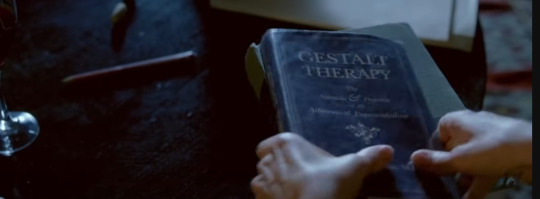
Figure 20. "None of what I've heard makes him a murderer."
So, how can we gather this up to develop the investigation? Utilizing only these two fundamental concepts, we can make a few assumptions.
The big question here is if whether or not Nigel's hands were present by Alex's when the trigger was pulled, which would lead the police to support or oppose Alex's narrative. Chemical examination with organic solvents (which won't cause preocupant harm to a dead body) and analytical methods could immediatly point to the presence of GSRs or biological/non biological BM. If Nigel's hands were elevated in his head level (or superior) in the instant of discharge, trace amounts of discussed metals/elements coming from the firing mechanism and ammunition, as weel as little to some biological material, would definetly be found in his hands and forearm skin since there was no clothing covering. Any substance found in his hands/forearm could be microanalytical compared to the ones present in Alex's hands, clothes and face as well. This could be done with really small samples of fresh skin. On the other hand, if Nigel's arms were lowered at the instant of discharge, we could still expect the presence of GSRs in his arms (yet, in less amounts) but the abssence of backspatter materials most certantly. This would classify Alex as a murderer without excuses, even if he alleged that Nigel asked for it.
In the scenario where Alex discharges at Nigel from a great distance (configuring simply murder) we could note the abssence of GSRs in every part of Nigel's body except for the targeted region (perhaps if they were at a greater distance to each other) and the presence of these GSRs in Alex, but in much higher concentration.
But the enviromnent's conditions are of primordial importance. Nigel and Alex stand in an open area, with considerable wind, heavy rain and gravel soil. The heavy rain could simply carry way much of these residues from Alex's body, clothes and Nigel's hands as well. Most GSR would probably be lost to those conditions and its deposite upon the soil's surface would be extremely hard to be quantitatively analized due to unknown degrees (elevated) of impurities and diverse materials and dirt present, but qualitative tests would still be valid.

The knowledge about the victim, crime scene, shooter, exact firegun and time of the tragic event allied with the fast action from authorities saves most of the police's efforts on identifiying and tracking down evidences. However, what remains still offers a challenge. The best evidence here, GSRs left by the discharge, would be of questionable help considering the presence of heavy rain in sight. Still, analitical quantities of them, if detected in Nigel's skin by proper chemical and espectroscopy-related analysis, can be used to comparate probable ammounts present in Alex's clothing and skin (despite the difficult of such). With that being said, the police would find themselves in a much more complex case of muder/assisted suicide, and further evidences and information about their relationship and recent whereabouts would ineviatably need to be extracted from external sources (such as parents, school's employess, close friends and students). Despite all this, Alex's final acting of removing Susan's body and disapearing from sight (not to mention the card left in Sally's car) immediatly sustent his guilt in a case where he already was the main suspect and basically confirmed criminal. And you know, breaking into a cemetery and extracting a corpse from its grave is definetly worth of some jail time. The Colbie's House Murder would certainly incriminate Alex for homicide as well, and the current Brotherhood's little political influence wouldn't prevent him from this destiny, as it appears. But the case is not over.
Further evidences were to be discussed, if it was not for the dissapearing of Alex Forbes.
The subject now roams unknowingly through England with mysterious intents. Its participation on the described case still lacks formal arguments and the Court should now approve his arrest warrant and search decree. Alex Forbes will most probably live to perpetrate the deluded fantasy responsable for the death of three young students in order to carry the sacred holy burden of an ancient templar bloodline.
Yet, we pray.


Who's the enemy now? We are.
4. Bibliography
[1] Euteneuer J, Courts C. Ten years of molecular ballistics-a review and a field guide. Int J Legal Med. 2021 Jul;135(4):1121-1136. doi: 10.1007/s00414-021-02523-0. Epub 2021 Feb 16. PMID: 33594457; PMCID: PMC8205864. [2] https://spotterup.com/how-ammo-works/ [3] Serol, M.; Ahmad, S.M.; Quintas, A.; Família, C. Chemical Analysis of Gunpowder and Gunshot Residues. Molecules 2023, 28, 5550. https://doi.org/10.3390/molecules28145550 [4] Guanchao Lan, Jing Li, Guangyuan Zhang, Jian Ruan, Zhiyan Lu, Shaohua Jin, Duanlin Cao, Jianlong Wang, Thermal decomposition mechanism study of 3-nitro-1,2,4-triazol-5-one (NTO): Combined TG-FTIR-MS techniques and ReaxFF reactive molecular dynamics simulations, Fuel, Volume 295, 2021, 120655, ISSN 0016-2361, https://doi.org/10.1016/j.fuel.2021.120655. [5] https://www.hunter-ed.com/national/studyGuide/How-the-Shotgun-Shoots/201099_92815/ [6] https://www.invaluable.com/auction-lot/era-410-ga-single-shot-break-action-shotgun-131-c-8284a72a5b [7] https://firearmland.com/item/1079096107 [8] https://www.letsgoshooting.org/resources/articles/shotgun/meet-the-shotgun/ [9] https://www.atf.gov/firearms/firearms-guides-importation-verification-firearms-ammunition-and-implements-war-top-break [10] Virginie Redouté Minzière, Céline Weyermann, Organic and inorganic gunshot residues on the hands, forearms, face, and nostrils of shooters 30 min after a discharge. Science & Justice, Volume 64, Issue 5, 2024, Pages 557-571, ISSN 1355-0306, https://doi.org/10.1016/j.scijus.2024.08.002. [11] Joshua Hallett, Michael Stolk, Michael Cook, K. Paul Kirkbride, Examination of gunshot residue arising from shotgun cartridges containing steel, bismuth or tungsten pellets. Forensic Science International, Volume 306, 2020, 110096, ISSN 0379-0738, https://doi.org/10.1016/j.forsciint.2019.110096. [12] https://www.bka.de/EN/OurTasks/SupportOfInvestigationAndPrevention/ForensicScience/PhysicalEvidence/Homicide/GunshotResidue/gunshotresidue_node.html [13] Francesco Saverio Romolo, Pierre Margot, Identification of gunshot residue: a critical review. Forensic Science International, Volume 119, Issue 2, 2001, Pages 195-211, ISSN 0379-0738, https://doi.org/10.1016/S0379-0738(00)00428-X. [14] Jalanti, T & Henchoz, P & Gallusser, Alain & Bonfanti, M.S.. (1999). The persistence of gunshot residue on shooters’ hands. Science & justice : journal of the Forensic Science Society. 39. 48-52. 10.1016/S1355-0306(99)72014-9.
Extra
random materials, take a look
1. Chemistry of Explosives (book pdf) https://link.springer.com/chapter/10.1007/978-1-4612-0589-0_5 2. ERA 410 GA video 1 https://www.youtube.com/watch?v=lGWm2aaWVAc&ab_channel=SteadFastCourage 3. ERA 410 GA video 2 https://www.youtube.com/watch?v=2S16C5Y6lxY&ab_channel=esquad540 4. Quick discussion about Smokeless Powder on r/guns https://www.reddit.com/r/guns/comments/1tawwm/things_i_want_you_to_know_about_smokeless_powder/#:~:text=Because%20of%20something%20called%20oxygen,and%20temperatures%2C%20leading%20to%20fouling. 5. A little on the kinetic energy of specific projectiles (everything applies here as well) https://nodoroc.com/d/node/20 6. A little more on ammunition Caliber https://www.globalsecurity.org/military/systems/munitions/bullets2-types.htm#google_vignette
For the sake of archieving, here are some shotguns I've separated to double check during my research until the Era 410 GA appeared. Curious enough, number 7, called "boito", appears to be another common name given to Era 410. Woops.
1. https://www.bidsquare.com/online-auctions/north-american-auction/victor-break-action-single-shot-12-ga-shotgun-4988316 2. https://www.crescentcityauctiongallery.com/auction-lot/stevens-arms-.410-gauge-single-shot-break-open-sh_9F84899825 3. https://palmettostatearmory.com/jts-shotguns-single-shot-410-bore-26-single-shot2.html 4. https://en.wikipedia.org/wiki/File:Stoeger-Coach-Gun.jpg 5. https://www.gunsinternational.com/guns-for-sale-online/shotguns/harrington-richardson-shotguns/h-r-bay-state-20-ga.cfm?gun_id=103017190 6. https://www.bankstowngunshop.com.au/product/12g-unknown-model-unknown-single-barrel-blued-wood-28-barrel-poor-condition/ 7. https://www.bankstowngunshop.com.au/product/410-boito-model-reuna-28-single-barrel-blued-timber-3-chamber-sec9622/ 8. https://www.bankstowngunshop.com.au/product/12g-harrington-richardson-model-1908-single-32-barrel-blued-wood/ 9. https://www.bankstowngunshop.com.au/product/12g-norinco-model-std-single-barrel-30-shotgun-great-condition/1 0. https://www.bankstowngunshop.com.au/product/12g-raick-freres-model-unknown-single-barrel-30-shotgun-belgium/ 11. https://gritrsports.com/henry-repeating-arms-single-shot-12ga-shotgun-h015-12 12. https://www.tmguns.co.uk/store/p1418/Tomas_Agote%2C_Eibar_12G_single_hammer_ejector_shotgun.html 13. https://www.tmguns.co.uk/store/p1659/Vanguard_Game%2FVermin_.410_hammer_ejector_single_barrel.html 14. https://www.tmguns.co.uk/store/p1290/Astra_Ciclope_12G_single_barrel_hammergun.html 15. https://www.tmguns.co.uk/store/p1883/Rossi_Game%2FVermin_20G_single_hammer_ejector_shotgun.html 16. https://en.wikipedia.org/wiki/File:Stevens_511_Shotgun.jpg 17. https://www.gunsinternational.com/guns-for-sale-online/shotguns/harrington-richardson-shotguns/harrington-richardson-44-smoothbore.cfm?gun_id=102901609
thank you for reading

#like minds#murderous intent#nigel colbie x alex forbes#nigel colbie#alex forbes#forensic science#analysis#Spotify
27 notes
·
View notes
Text
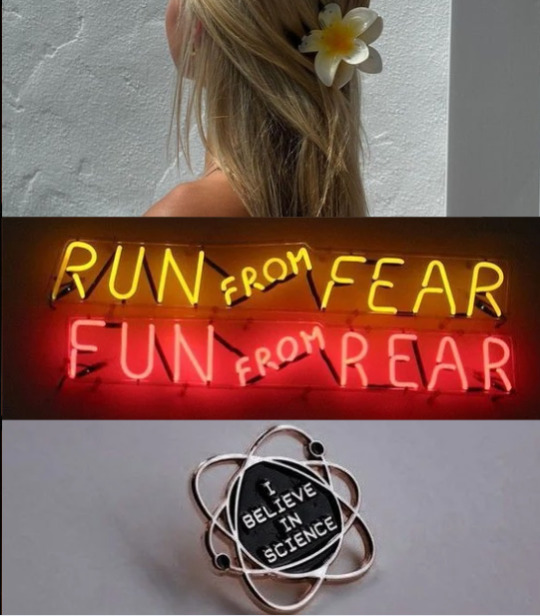
Name: (....) Smith-Allen
From: Central City
Class: 4-B
Family:
Bartholomew Allen (father)
Leia Smith (mother)
Leonard Snart (uncle) (yes, that Leonard Snart)
Lisa Snart (aunt)
A quick mind with an extensive knowledge in physics and forensic pathology. Her long-term goal is to become a biochemical scientist. Her short-term one is to make her eco-friendly biotech projects a reality without blowing up a lab again. Preferably before she turn 25.
Her interests extend to atomic and molecular physics as well, particularly in the medical applications of matter manipulation.
Diagnosed with ADHD, which, in her own words, can be "her best ally or worst enemy with a flick of a coin". Her brain's ability to focus on multiple concepts at once makes her work more efficiently than most—until she's overstimulated. Then, she usually falls into creative blocks. She takes prescripted pills for this.
Note: She once built a sustainable hydroelectric generator in her former school's bathroom using leftover science fair scraps. It worked—for ten minutes. Apparently, the hallway still smells faintly of ozone.
......................................................
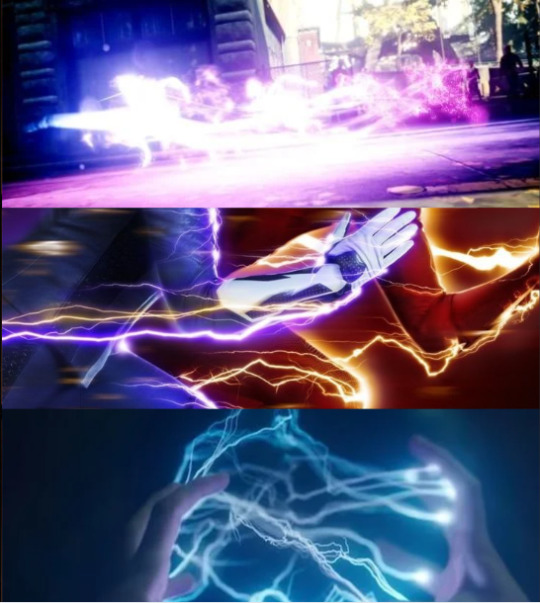
Codename: Velocity
Species: Meta-human (Speedster)
Team: Task Force Z (The Orphans)
Abilities: As a meta-human, she possesses a superspeed that allows her to move faster than sound, just like The Flash. This power extends to her reflexes and agility, enhancing them to the point she's almost untouchable in combat. At the same time, she's able to manipulate the very atoms in her body to make herself intangible, passing through solid objects or letting projectiles harmlessly pass through her. This makes her ideal for high-level espionage and extraction missions, since no facility can keep her out, and a deadly opponent in a fight. She has a natural accelerated healing, but she can speed up the process even more at will.
Research team note: It's been proven she can generate electricity with her body by vibrating fast enough, allowing her to produce and manipulate electrical energy to a limited extent. We believe this is directly tied to the nature of the accident that triggered her meta-gene. Awaiting approval for new tests to confirm how far this limit goes.
Weakness: Extreme temperatures, concretely cold. It drastically slows her down and, in the right concentration, it shuts her powers off entirely, including the healing factor. Captain Cold's ice gun is a perfect example for it.
Emergency contacts:
Dr Leia Smith (mother)
Lisa Snart (aunt)
Wallace West (close friend)
Note: The last two should ONLY be called if Dr Smith can't be located by any means.
Observations: She and Captain Boomerang have a very friendly relationship, usually teaming up to prank the staff and cause havoc together during their breaks. He's been a big part of her training, even questioning Rogers' methods openly. According to some officers, he has threatened the research team a couple of times regarding their tests on Velocity. This bond should be taken into consideration in the future...
...............................
m.list
A/N: If someone wants to be tagged from now on this au, let me know ���
#dc scenarios#dc x reader#dc fanfic#justice league x reader#yandere justice league x reader#yandere justice league#suicide squad#suicide squad x reader#superman x reader#batman x reader#wonder woman x reader#the flash x reader#green lantern x reader#green arrow x reader#black canary x reader#aquaman x reader#neglected reader#clark kent x reader#bruce wayne x reader#diana prince x reader#barry allen x reader#hal jordan x reader#oliver queen x reader#dinah lance x reader#arthur curry x reader#task force x#amanda waller#justice league's neglected kids
30 notes
·
View notes
Text
I was just reminded that the art collective Forensic Architecture exists and once again I’m disgusted.
For those of you who don’t know, it’s a collective of various artists who play at forensic science, conduct “forensic investigations”, and then make art exhibits of their “results”. Their reports and exhibits will make statements such as “the evidence shows that X is linked to Y” but the statistical output that they share will show something like a 5% confidence in the match.
That's right. They make art exhibits of their "investigations".
You want to talk about fandomizing tragedy? Making “forensic investigations” into art exhibits is the bougiest version I can think of, and it's only to serve an echelon of people who enjoy that kind of stuff. If any of the people in this art collective had a background in forensic science they would have taken ethics courses that would tell them how horrid putting on an art exhibit like this actually is. You don't honor the victims by putting on an art show for the rich and powerful to gasp and faint over so that you can fundraise for your next show.
Their founder has even stated that they’re not in forensics but “counter-forensics” and "counter-investigation". They eschew the practices and norms of the scientific community for telling their own version of investigative “truth”. They’ve even gone so far as to quote post-truth philosophies in their work and the controversial Nietzsche quote about there being no facts, only interpretations. Both are dangerous philosophies to hold in forensic science as it presents the evidence as subjective rather than objective. This is why they're an art collective and not a forensic science research group as they purport, they're rejecting objective scientific outcome for subjective interpretation.
You can go to the group's website and they have profiles on all of their team members. Almost every person is labeled as a "researcher", but once you click on their profile it quickly tells you that they're an artist, designer, activist, or some combination of the three. No mention of any scientific background whatsoever. That indicates their ability to actual conduct forensic science research is not great as they don't have any training or education on the methods involved. In fact, their entire program and personnel are out of an arts college with no science programs or faculty outside of anthropology.
That's weird, right?
A group that supposedly made a new discipline of forensic science, according to them, has no members with actual backgrounds in forensic science or scientific disciplines relating to it?
None of the team member profiles detail any scientific background that would be relevant to forensics outside of a few people with engineering and computer science degrees. Neither of the aforementioned disciplines typically train you in forensic practices anyway unless you take certain courses. Because these profiles are public you can go and checked LinkedIn profiles and find the CVs for each member as well. Guess what? No forensic science or relevant scientific backgrounds listed there as well.
But for some reason this art collective has received funding from governments and NGOs for "creating" a new discipline of forensic science. They're a "trusted" source for forensic investigations. That's worrying. That's terrifying.
I'm a forensic scientist and to make an objective field based upon methodology and empirically supported practice into one that is subjective and throws out the empirical aspects is terrifying. Everyone should have klaxons going off in their head whenever they see Forensic Architecture's name appear in a publication. I've reviewed a few of their "investigations" and they are rife with bad practice, manipulation, and misinformation. In fact, it appears that they present their work in art exhibits more than they testify to it in court due to their methods being questionable and their intent being not to help the investigation but to be a "counter-investigation" that can be judged by the court of public opinion. What do I mean by this? In many of their investigations the collective does not actively have personnel at the scene. Meaning they are not getting first hand physical evidence and measurements. Now, it's not always possible to be there personally and as such you rely upon crime scene techs, investigators, and other personnel to collect this stuff. Typically if you're a consultant or outside firm you are getting the evidence after it has been collected for analysis. You want the physical evidence in your hands as much as possible so that you can analyze it properly. Sometimes you have to request going to the scene yourself to get the measurements and evidence you need. The worst type of evidence to receive is honestly digital images of the scene as you are now having to analyze something a general investigator, who likely does not have specialized training, took a picture of.
In situations where you cannot have the physical evidence for analysis and you are left with only photographs then a forensic expert should be tempering their responses and conclusions. You cannot confidently come to conclusions based simply on looking at photos. This is something that is hammered home repeatedly in forensic programs and professionals.
In the case of warzone crime scene analysis, as FA typically does, they are, typically, not collecting evidence first hand from the scene, nor are they receiving evidence secondarily from actual trained investigators (when they are there first hand they also rely excessively upon expensive technology instead of best practices). They rely upon third party photos and satellite imagery to do their analysis.
Time and time again, forensic experts who rely solely upon digital photos and media to make their analysis get ripped apart by a good lawyer. Being confident in conclusions based upon photographs is the easiest way to lose your credibility. But again, the art collective playing forensic scientist primarily puts their work in art exhibits where they are not scrutinized by experts. Hell, I don't think I've ever seen them present at one of our professional conferences nationally or internationally (I would love to be a fly on the wall when that happens).
And finally, if this was an actual credible scientific group that produced credible investigations and had created a brand new field with methodology that stood to scrutiny there would be publications in the forensic journals detailing this. Especially from the "creator" of the field Eyal Weizman.
Guess what there isn't?
But in the end all they’re actually doing is crime scene reconstruction from people who want to cosplay as forensic scientists.
(for more reading on the group see this article that highlights issues with FA from another perspective https://www.artnews.com/art-in-america/features/forensic-architecture-fake-news-1234661013/)
#Forensic architecture#forensic science#Forensic Architecture is not made of forensic scientist but of artists#Forensic Architecture admittedly does not follow established forensic practices and principles#This is the group that Western Activists will share as “proof” for the “crimes” of Israel#Their rejection of scientific methodology is all you need to know about the veracity of their “proof”#They use tertiary evidence in their analysis and very rarely provide an actual report on their methodology - which is horrific#FA is being used by antisemites as an “authority” and they should be summarily ignored for poor scientific practice
66 notes
·
View notes
Text
Flower of a Poisonous Seed Part 52:
Part 51:
Tw: hate crime, vandalism, racism,
"So that's the plan. What do you think, Father?"
"I don't like any of what has happened recently, but I understand the precautions we must take moving forward. Perhaps you can take your mother with you. As much as I trust Nezha to have chosen good company for the task, I would prefer one of our own to be there by your side."
Erlang Shen drove them to Wukong and Nezha's house.
They were absolutely devastated at what they saw.
PIF: *in shock* Oh, my stars. Was it like that when you left, my child?
RS: No. No, this is far worse. The flowers are new, though.
On the sidewalk outside the picket fence were bouquets of fresh pink carnations and blue hyacinths. Signs and notes of support and love accompanied them. Packs of unused incense were laid there too. Beyond that, the house looked more like a war zone.
Someone had set fire to the yard leaving black ash in its wake. The smoke from the fire had turned the originally blue-green walls an unsavory gray. Every window was broken.
Jing: Stay on alert in case traps have been laid. We can never be too certain.
Erlang: Even if it is safe, there's no way that house is in good enough condition to be lived in.
PIF: Still, we should investigate the damage. Save any belongings that may be intact, and see if was isn't can be restored.
RS: Agreed. Cousin was wise to instruct us to take the objects we held most dear to us, but many things were left behind in favor of haste, practicality, and necessity.
Jing: Wukong's been excitedly showing Macaque pictures of their grandchildren, so at least the photo albums were spared.
RS: *laughs* As they should be.
The inside wasn't much better. Porcelain tableware and picture frames were smashed on the floor. The TV had an axe in it. The house was built out of fireproof materials but all inside that could've been burned was burned.
Red Son stepped out onto the back porch. His Uncle's favorite tea set had signs of mended breaks that weren't broken a week ago, neglected in the rush to safety. It was one of the few things Wukong had brought with him when he moved in with Nezha. It was a wedding gift from Guanyin, one that was used daily by the happy couple and yet somehow managed to survive the childhoods of their offspring.
A bold and black-hearted soul destroyed the tea set. Then a brave and kind soul took the time to mend it.
Red Son just wished he knew who to thank.
~~~
Princess Iron Fan stepped carefully through the master bedroom's bathroom. It wasn't much of a bathroom anymore.
The mirror was, unsurprisingly, shattered. Shards and medicines littered the floor. The bathtub and toilet looked like someone had taken a sledgehammer to them.
Iron Fan went back into the master bedroom to make her leave. That's when she spotted a photo of Wukong and Nezha behind the door, missed by whoever rampaged through there.
The photo featured the two holding hands while walking down the stairs. Nezha was being led by a round, curly-haired Wukong. They were smiling.
Iron Fan felt her heart break like the mirror.
She held the photo in her shaky hands as she wept for a dozen reasons.
~~~
Erlang took gentle care to lift fingerprints off of the axe lodged in the TV. He only knew basic forensic science, but a sample could help find the culprit(s) responsible.
Xiaotian Quan sniffed around for any trace of the culprit's scent.
Erlang takes his role as Co-ruler of the Celestial Realm very seriously. Jing took on the legislative role while he was in police and military affairs both foreign and domestic. This qualified as a domestic threat. Even if it didn't, he wouldn't let this thing slide.
He didn't know or care for Macaque that well but Wukong is a brother. Erlang would rip the heavens from their foundation if that's what it took to keep Wukong safe. Now more than ever, Wukong needed people who would protect him from harm.
~~~
Jing: *over the phone* Son... I'm so sorry.
Nezha: *sobbing* Oh gods, why?
Jing: We'll be taking home whatever we can salvage, but... it won't be much.
Nezha: That's okay, Father. We can get by without much.
Jing: I will collect what I can. I love you son. I will support you both in any way I can.
Nezha: Thank you, Father. Goodbye.
Jing: Goodbye.
Nezha: *hangs up* *turns to Wukong*
SWK: *tears streaming down his face*
Nezha: *crying* You caught all that?
SWK: *nods* *cries silently*
Nezha: *faking a smile* Guess it's time to look for a new place to live!
SWK: *fakes a smile back* *hugs him*
Nezha: At least there's flowers for you.
SWK: *between quiet sobs* Pink carnations and blue hyacinths mean "Sorry". Not everyone is our enemy.
Nezha: *sobs loudly* Beautiful darling! I should hope so!
The two break down crying in each other's arms. They know they'll survive this storm together. But today? Today they mourn the home they lost. The one they made together. The one they planned to spend eternity in. As usual, life had other plans.
Part 53:
Masterpost
@weaverpop @istopaskingmemate @ainnur @starrclown @cutvdo @swkbiggestdefender @fruit-fight
#lego monkie kid#lmk#legomonkiekid#lmk sun wukong#lmk swk#lmk sunwukong#lmk monkey king#lmk wukong#lmk fanfic#lmk fanfiction#lmk fan fiction#lmk fic#flower of a poisonous seed#floaps#lmk demon bull family#lmk demon bull king#lmk dbk#lmk princess iron fan#lmk pif#lmk red boy#lmk redson#lmk red son#lmk erlang shen#lmk erlang#nezha lmk#lmk nezha#lmk li nezha#lmk li jing#lmk xiaotian quan#lmk royalty duo
14 notes
·
View notes
Text
𝐭𝐡𝐞 𝐮𝐦𝐛𝐫𝐞𝐥𝐥𝐚 𝐚𝐜𝐚𝐝𝐞𝐦𝐲 𝐝𝐫


number seven . . faye hargreeves . . the psychic
born october 1, 1989
powers: her powers were the opposite of ordinary. though they seemed basic; having telekinesis, she had additional abilities that shocked even sir reginald hargreeves.
𝜗𝜚 telepathy : the ability to communicate entirely in the mind without saying anything.
𝜗𝜚 mind walking : the ability to enter the mind of another person.
𝜗𝜚 psychic projection : the ability to voluntarily project an astral body or mental body, being associated with the out-of-body experience, in which one's consciousness is felt to separate from the physical body temporarily.
𝜗𝜚 memory reading : the ability to read a target's memory to learn their history, discover lost memories and help the person remember, learn a memory that the target is unaware of.
𝜗𝜚 psychometry : the ability to learn information about the past of an object or those who interacted with i.
style: she is the more “colorful” one of the bunch: often wearing brightly colored pieces of clothing in contrast to her siblings’ appeal to more mute hues. she thrived in the fashion aspect of the 60’s. adoring her brightly colored rectangle dresses paired with cute accessories.
occupation(s): in the original timeline — the umbrella academy 2019 — she studied to become a forensic science teacher at a high school in new york city.
in the 60's timeline, she was thankful to have been taken in by a sweet japanese family who allowed her to work in their flower shop.
in the sparrow timeline, she didn't have a job because they did not stay there for long. only 10 days to be exact.
in the "no powers" timeline, she found her place again as a forensic science teacher.
significant other(s):

season one
girlfriend . . ramona pruett
born march 25, 1991
ordinary in power, but has a special place in my heart.


season four
fiancé . . joshua hong
born december 30, 1990
also ordinary in power, but is the only man I could truly love.

#the umbrella academy dr#shifting#reality shifting#shifting reality#shiftblr#drself#intended reality#desired reality#shifting antis dni#shifting community#reality shifter
9 notes
·
View notes
Text
🧪🕵️♀️ RISE FROM THE ASHES: DAY 2 INVESTIGATION – DIGGING DEEPER! 🕵️♀️🧪
Just when we thought it couldn’t get weirder—Day 2 Investigation is here, and the evidence is piling up faster than we can shout OBJECTION!
💥 What’s on the docket? 🧪 Ema's science brain vs. Phoenix's last nerve 👀 Forensics, fingerprints, and possibly ... forged evidence?
🔍 Examining the evidence from every angle 💬 Surprising faces and unexpected locations 📸 Plenty of yelling, thinking, and maybe panicking (just a little)
📅 When? NOW 📍 Where? HERE 💬 Why? Because the truth is buried under so many contradictions.
Come solve this chaos with @lacystar and me —and maybe get emotionally wrecked in the process. Justice never rests, and neither do we. 🧬⚖️
#AceAttorney#RiseFromTheAshes#PhoenixWright#EmaSkye#TwitchStreamer#Objection#VisualNovels#GamingCommunity#SpoilerFree
4 notes
·
View notes
Text
And this is a purely materialistic rational statement; it is independent of any objective hierarchy at all. Philosophy has nothing to say; and Science can only suspend judgment, pending a proper and methodical investigation of the facts alleged.
Agent Gamble, a field ops agent of the Forensic Department of Paranormal and Demonic Activity, has disappeared while pursuing a confidential investigation for the department. His department head, Agent Pallas, believes his disappearance to be connected to the case he was working on, and has requested three agents unconnected to Field Ops to pick up his work and locate him if possible.
4 notes
·
View notes
Text
Multiple Choice Questions on Forensic Physics
Continue reading Multiple Choice Questions on Forensic Physics
#forensic physics mcq#forensic science mcq#mcq on forensic physics#Mcq On Forensic Physics With Answers#Objective On Forensic Physics
0 notes
Text
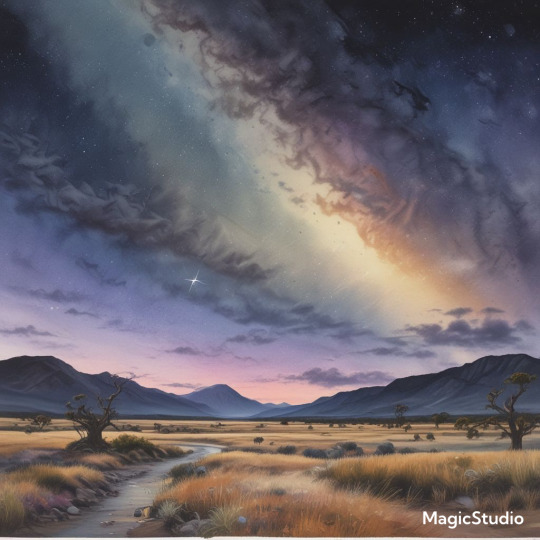
Uncharted Skies: Exploring the Mystery of UAPs
The study of Unidentified Aerial Phenomena, or UAPs, has long been a topic of fascination and debate, with some approaching the subject with skepticism and others dedicating themselves to understanding these enigmatic events through a scientific lens. Dr. Kathleen Murray, a scientist with a background in forensic science, geoscience, and education, brings a unique perspective to the field, combining her expertise with a passion for nature and the universe. Her journey into the world of UAPs began with a remarkable sighting in 1997, where she witnessed a small, stylized object moving within an equilateral triangle of stars in the desert, an experience that sparked her curiosity and set her on a path of discovery.
Dr. Murray's research on UAPs is characterized by a combination of observation, recording, and analysis, as she uses binoculars with 36x optical zoom to capture videos of these phenomena, which she then meticulously analyzes using software such as Stellarium and Flight Radar 24. One of her most recent sightings, which took place on the 4th of March, is particularly noteworthy, as it involved a flashing object moving from south to west that she was unable to identify as a satellite or aircraft. Despite consulting with an astronomer and checking with Flight Radar 24, Dr. Murray was left with more questions than answers, highlighting the complexities and challenges of studying UAPs, where the lack of concrete evidence and the abundance of unknowns can make it difficult to draw conclusions.
Dr. Murray's approach to investigating UAPs is marked by a commitment to scientific inquiry and a willingness to consider alternative explanations for these phenomena. She recognizes that there is still much to be learned and that it is essential to approach the subject with an open mind, avoiding the pitfalls of skepticism and dogma. By doing so, Dr. Murray hopes to contribute to a greater understanding of UAPs, which may, in turn, shed light on the mysteries of the universe. Her use of technology, such as binoculars and software, allows her to collect and analyze data in a systematic and rigorous manner, while her decision to share her findings with others, including the scientific community, reflects a commitment to transparency and a desire to advance our understanding of UAPs.
Dr. Murray's exploration of the possibility of summoning UAPs, using techniques such as the Gateway Experience program, music, and visual imagery, demonstrates her willingness to think outside the box and consider unconventional explanations for these phenomena. Although these attempts have been unsuccessful, they reflect her openness to new ideas and perspectives, an essential quality in a field where the unknowns are so great and traditional explanations may not be sufficient. By embracing this openness and commitment to scientific inquiry, Dr. Murray's work on UAPs serves as a model for how to approach complex and mysterious phenomena, and her contributions to the field may ultimately help to shed light on the nature of reality itself.
Dr. Kathleen Murray: Pulsing Orb (UAP Files Podcast, March 2025)
youtube
Tuesday, March 11, 2025
#uaps#unidentified aerial phenomena#science#research#astronomy#space#mystery#unexplained phenomena#discovery#interview#footage#ai assisted writing#machine art#Youtube
10 notes
·
View notes
Text
Object permanence
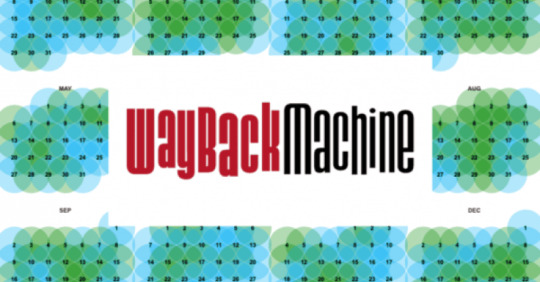
Picks and Shovels is a new, standalone technothriller starring Marty Hench, my two-fisted, hard-fighting, tech-scam-busting forensic accountant. You have TWO DAYS LEFT to pre-order it on my latest Kickstarter, which features a brilliant audiobook read by Wil Wheaton.

#20yrsago What if Bill Gates hired Linus Torvalds? https://web.archive.org/web/20050207155531/https://www.wired.com/wired/archive/13.02/microsoft_pr.html
#15yrsago Rogers Canada forces Android update that takes away root access https://mobile.slashdot.org/story/10/01/26/2358237/Canadian-Android-Carrier-Forcing-Firmware-Update
#15yrsago Sane copyright doesn’t treat all copying as the same https://www.theguardian.com/technology/2010/jan/26/copyright-cory-doctorow
#15yrsago ACTA: the leaked secret memos https://web.archive.org/web/20100130005036/https://www.michaelgeist.ca/content/view/4730/125/
#10yrsago Plan C: The top secret Cold War plan for martial law in the USA https://www.muckrock.com/news/archives/2015/jan/26/plan-c-top-secret-cold-war-battle-plan-bring-unite/
#10yrsago Google strong-arms indie musicians into accepting brutal, crowdfunding-killing deal for streaming service https://zoekeating.tumblr.com/post/108898194009/what-should-i-do-about-youtube
#10yrsago Great Firewall of Cameron blocks sex-abuse charities https://www.theguardian.com/technology/2015/jan/24/internet-filters-block-sex-abuse-charities
#10yrsago The Haunted Mansion was almost the Tiki Room https://longforgottenhauntedmansion.blogspot.com/2015/01/walt-disneys-enchanted-creepy-room.html
#5yrsago Two years after a federal law banning shackling women during childbirth was passed, prisoners in America are still giving birth in chains https://www.theguardian.com/us-news/2020/jan/24/shackled-pregnant-women-prisoners-birth
#5yrsago Andrew Cuomo’s naked hostility drives out MTA president Andy Byford, the “Train Daddy” who has transformed the world’s rail systems https://www.railwayage.com/passenger/you-blew-it-andrew-cuomo/
#5yrsago Fatal car wrecks are correlated with stock-market fluctuations https://www.sciencedirect.com/science/article/abs/pii/S0167629619301237
#5yrsago Banks have returned to the pre-2008 world of automatic credit-limit increases for credit cards used by already indebted people https://www.bloomberg.com/news/articles/2020-01-23/banks-are-raising-credit-card-limits-without-asking-customers
#1yrago The long sleep of capitalism's watchdogs https://pluralistic.net/2024/01/26/noclar-war/#millionaire-on-billionaire-violence
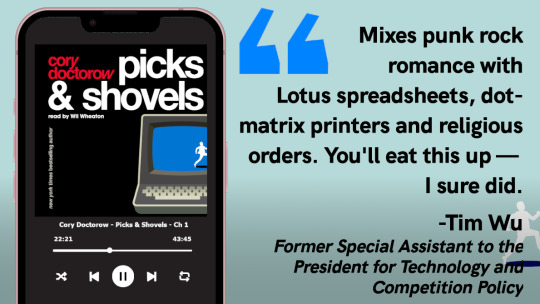
Check out my Kickstarter to pre-order copies of my next novel, Picks and Shovels!
8 notes
·
View notes
Text
I was just thinking about forensic science. When a dead human body is found with no form of i.d on them, long been dead so mostly skeletal, do you think they use a ouija board to ascertain a persons identity?
Me neither, so you can fuck off with your 'there is no objectively real sex'. You will be correctly sexed, if your dead body is found. Bet your decaying arse on it.
8 notes
·
View notes